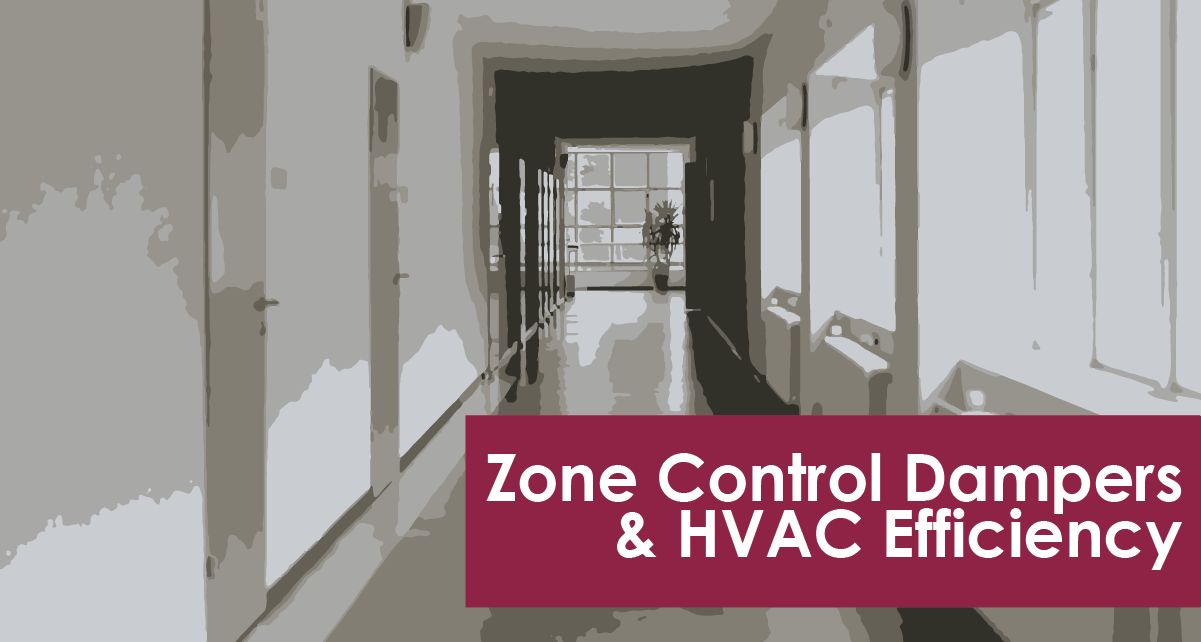Zone control dampers help you divide the workload for your HVAC system. Learn how compartmental design can keep your system efficient, no matter the size.
Getting Air to the Right Place
Imagine a school building with several classrooms, where only a few classrooms will be occupied throughout the day. Without established zones, the HVAC system will push air to every classroom including the ones that are empty.

There won’t be a lot of overlap in these larger spaces. It will take a lot of energy to achieve the right temperature in the occupied rooms. By establishing zones, you can focus the efforts of your HVAC system and provide comfort for students in the occupied rooms. You can create these zones in your system with help from zone control dampers.
Establishing Zones in HVAC
The goal of any HVAC system is to condition air and move it to where the air is needed. Ductwork connects rooms, offices, kitchens, and other interior spaces to the central air conditioning system. The ducts provide pathways for airflow to move from the HVAC unit to the rest of the building.
In a small building, the system is typically designed to blast air through all ducts to bring down the temperature of every connected room.

Think of the HVAC system of a single-story house. There is usually only one air conditioner for the home. When you adjust the thermostat, the system pushes air to every room in the house. This design works to adjust temperatures throughout the home, so that every space achieves the same desired outcome.
Every room, whether hot or cold, receives the same airflow. In this scenario, the rooms of the home are usually close together so that the temperature across the house evens out.
This “full blast” method is fine for smaller residential projects, but it can be very inefficient on a larger scale. In our previous demonstration, you would need to cool the entire school building to keep the occupied rooms at the right temperature. With the right HVAC design, you can achieve comfortable conditions for those students without wasting power.

You need to establish zones in your HVAC system for buildings with many rooms and large interior spaces. Zones are areas of the building that can be heated or cooled separately from the other areas.
Commercial projects are typically divided into zones to help manage airflow, but certain residential projects can also benefit from a more focused approach to air conditioning. Zone control dampers can help you establish these areas. For example, let us return to the school mentioned earlier.
With zone control dampers, we can create zones for each classroom in the building. The system can focus on a single zone or address airflow needs in multiple zones with the right configuration.

When a teacher adjusts the thermostat, the HVAC system can direct air to that specific classroom. The zone control dampers will open for the target zone, and close for classrooms that don’t need the air. You save power by focusing the system’s efforts on the rooms that need airflow.
Designing Zone Control Dampers
In the louvers and dampers industry, we commonly shorten the name zone control damper to control damper, or volume control damper. Control dampers regulate the flow of air through your HVAC system by opening and closing their blades.
Dampers may look the same, but minor differences in design can change what they do in your HVAC system. For instance, a damper with opposed blade action is better suited for modulating air pressure in a duct. For another example, a backdraft damper can open and close on its own, with help from airflow and a counterweight, because the axles of their blades are off-center.

We offer several helpful articles on the MCDLG Newsstand to help make sense of control dampers, including tips on selecting the right dampers for your HVAC system. In this article, we will cover the basics of zone control damper design:
- Control dampers must be able to open and close to establish a zone. You will want to use control dampers with parallel blades.
- The damper should have a smooth blade profile to minimize the damper’s effect on airflow when the damper is open. This effect is called “pressure drop”.
- Control dampers should close tightly to minimize air leakage, so that airflow meant for one zone doesn’t bleed into another. Blade and jamb seals help minimize leakage.
- Control dampers should have the means to open and close on their own, so that the system can automatically address a zone’s needs. Electric actuators can help dampers achieve automation.
- Control dampers will need a regular maintenance schedule to ensure they can open and close when necessary. Prevent damage by cleaning and testing your control dampers on a regular basis.
The primary goal of a zone control damper is to open when the zone needs airflow and to close when the zone’s needs are satisfied. They can achieve this with air-efficient designs and the right accessories.

Designers will often choose control dampers with airfoil blades and electric actuators. Airfoil blades provide excellent airflow through the damper when it is fully open and can be equipped with seals to close tightly. Electric actuators provide the means to automate the damper’s blade action.
Automating Damper Action
Smart devices are on the rise in HVAC. To increase efficiency, building managers can install smart thermostats to monitor the conditions of individual zones. They can also add sensors in rooms to determine if an area is unoccupied.
Occupants can also control the conditions from connected apps, so that they can heat a meeting room before an important presentation. This smart automation can also extend to zone control dampers through their actuators.
When tied to the central HVAC system, electric actuators can open and close the damper as the zone requires. The system can provide the signal to the electric actuator to move the damper’s blades.

With this setup, an occupant can raise adjust the thermostat in their office and the HVAC system can do the rest. Zone control dampers will open the path to the office and distribute the required air. The result is a focused approach to HVAC that can help save energy overall.
While they are more common in commercial projects, HVAC zones can also be used in residential buildings and other areas that need a more focused air system. Zone control dampers help focus those efforts. When designing these zones, choose dampers that move air efficiently and close tightly when the zone is not in use.
If you find a damper that works, check its submittal for the key details. Always make sure your dampers will work for your intended application.

Starting a commercial project? Designing an HVAC system that will cover multiple zones? Start with a balanced approach. Air Balance builds zone control dampers for any HVAC project, big or small. We can help you fill those gaps in your system Contact Air Balance today and let's work together on your next project.
What are your thoughts on HVAC zones? Tell us in the Comments section below. We want to hear from you!
For more on control dampers, check out these other Newsstand article:
.webp?width=91&height=70&name=MCDLG%20Logo%20(Resize).webp)






